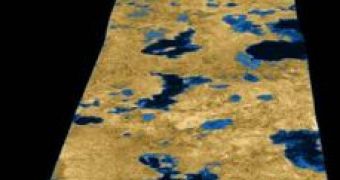Even if water is missing in other planets, this does not mean that there are no lakes.
Last July, Cassini got clear images that reveal in Titan, a Saturn's moon and one of the most Earthlike space bodies in the sun system, more than 75 liquid lakes. "At the time we first announced it, we were like, 'Well, we think these are probably lakes,' but that was about our level of confidence," said study team member Ellen Stofan of University College London and the California Institute of Technology. "I would say at this point, we've analyzed the data to the extent that we feel very confident that they are liquid-filled lakes."
Just a detail: Titan's lakes are filled with methane, possibly even ethane, organic molecules which on Earth environments are gases, but they are liquid on Titan's extremely cold ambient. "It's going to behave like water," Stofan said about methane on Titan. "It's transparent just the way water is. So if you were standing by the shoreline, you would be able to see down to whatever pebbles or gunk that was on the bottom."
Titan is the only moon in the sun system which possesses a dense hazy atmosphere with thin layers of methane and nitrogen vapors, very similar to a primordial Earth. Methane is sensitive to light and must constantly be renewed. It's possible that lakes or even oceans of methane might exist on, or just beneath, the moon's surface and evaporation from these sources may fuel the atmosphere with methane.
The lakes have been spotted on the moon's northern pole. "The lakes are basically black in the [radar] data, which is how a liquid would behave," Stofan said. "Radar data alone wasn't enough, however. A very smooth deposit of fine soil would also appear black on radar," Stofan explained.
Some lakes seem to be alimented by sinuous "rivers", some over 62 miles (100 kilometers) long. Others are located within circular depressions, like crater volcanic lakes on Earth. "The morphological evidence points completely away from it being a smooth deposit of soil or sediment. It's just not consistent," Stofan said. "Combining these two sets of data, it led us to feel very confident about the interpretation that they're actually liquid."
The Titan's rivers and lakes may be fueled by rainfall from methane clouds or from beneath the moon's surface. "You can think of all the exotic words you want to call it - a 'methanofer' because it's not an aquifer. It's a subsurface methane table and not a water table," said Stofan.
Scientists think the lakes may increase in the winter hemisphere while those in the summer hemisphere should shrink or entirely vanish.
Photo credit: NASA

 14 DAY TRIAL //
14 DAY TRIAL //